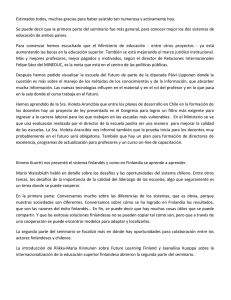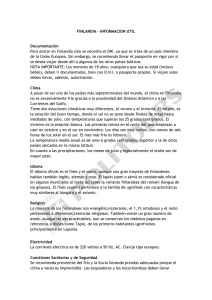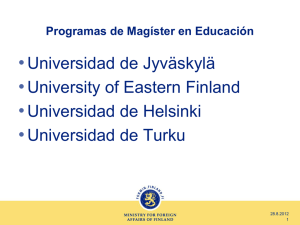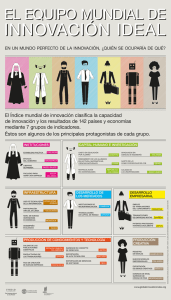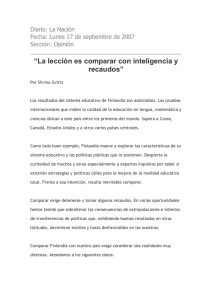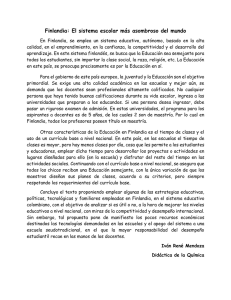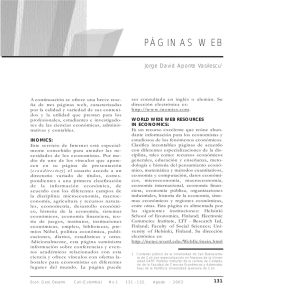PDF de 84 Kb
Anuncio
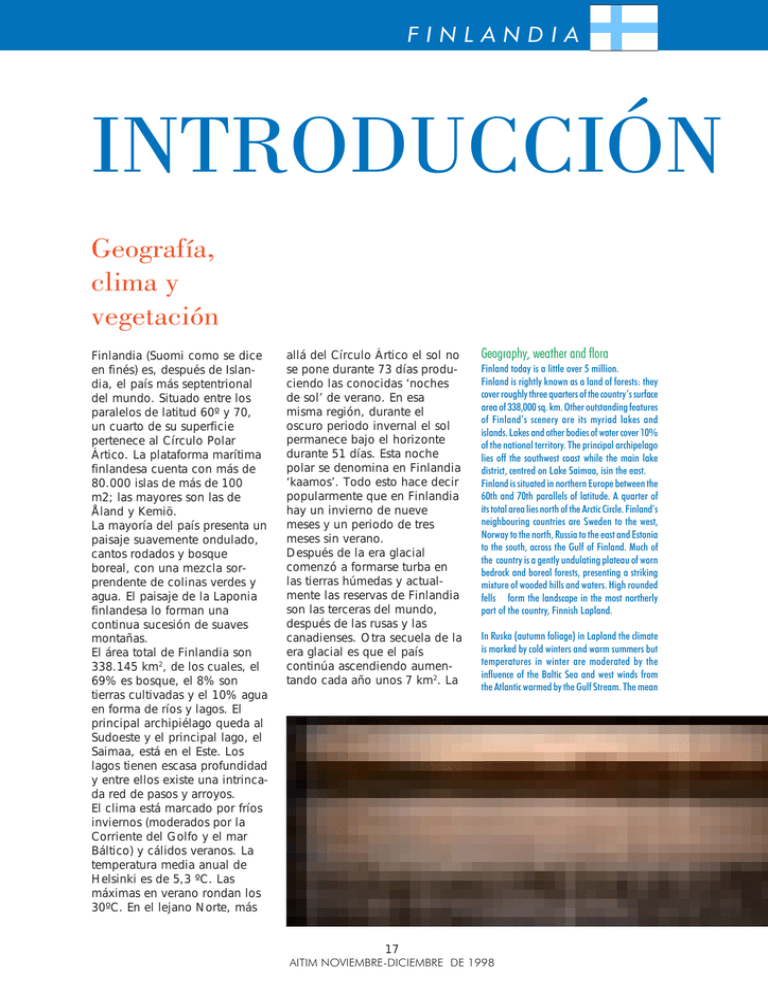
FINLANDIA INTRODUCCIÓN Geografía, clima y vegetación Finlandia (Suomi como se dice en finés) es, después de Islandia, el país más septentrional del mundo. Situado entre los paralelos de latitud 60º y 70, un cuarto de su superficie pertenece al Círculo Polar Ártico. La plataforma marítima finlandesa cuenta con más de 80.000 islas de más de 100 m2; las mayores son las de Åland y Kemiö. La mayoría del país presenta un paisaje suavemente ondulado, cantos rodados y bosque boreal, con una mezcla sorprendente de colinas verdes y agua. El paisaje de la Laponia finlandesa lo forman una continua sucesión de suaves montañas. El área total de Finlandia son 338.145 km2, de los cuales, el 69% es bosque, el 8% son tierras cultivadas y el 10% agua en forma de ríos y lagos. El principal archipiélago queda al Sudoeste y el principal lago, el Saimaa, está en el Este. Los lagos tienen escasa profundidad y entre ellos existe una intrincada red de pasos y arroyos. El clima está marcado por fríos inviernos (moderados por la Corriente del Golfo y el mar Báltico) y cálidos veranos. La temperatura media anual de Helsinki es de 5,3 ºC. Las máximas en verano rondan los 30ºC. En el lejano Norte, más allá del Círculo Ártico el sol no se pone durante 73 días produciendo las conocidas ‘noches de sol’ de verano. En esa misma región, durante el oscuro periodo invernal el sol permanece bajo el horizonte durante 51 días. Esta noche polar se denomina en Finlandia ‘kaamos’. Todo esto hace decir popularmente que en Finlandia hay un invierno de nueve meses y un periodo de tres meses sin verano. Después de la era glacial comenzó a formarse turba en las tierras húmedas y actualmente las reservas de Finlandia son las terceras del mundo, después de las rusas y las canadienses. Otra secuela de la era glacial es que el país continúa ascendiendo aumentando cada año unos 7 km2. La Geography, weather and flora Finland today is a little over 5 million. Finland is rightly known as a land of forests: they cover roughly three quarters of the country’s surface area of 338,000 sq. km. Other outstanding features of Finland’s scenery are its myriad lakes and islands. Lakes and other bodies of water cover 10% of the national territory. The principal archipelago lies off the southwest coast while the main lake district, centred on Lake Saimaa, isin the east. Finland is situated in northern Europe between the 60th and 70th parallels of latitude. A quarter of its total area lies north of the Arctic Circle. Finland’s neighbouring countries are Sweden to the west, Norway to the north, Russia to the east and Estonia to the south, across the Gulf of Finland. Much of the country is a gently undulating plateau of worn bedrock and boreal forests, presenting a striking mixture of wooded hills and waters. High rounded fells form the landscape in the most northerly part of the country, Finnish Lapland. In Ruska (autumn foliage) in Lapland the climate is marked by cold winters and warm summers but temperatures in winter are moderated by the influence of the Baltic Sea and west winds from the Atlantic warmed by the Gulf Stream. The mean 17 AITIM NOVIEMBRE-DICIEMBRE DE 1998 INTRODUCCION conciencia ecológica en cuanto al uso de pesticidas y agentes tóxicos. Algunas cifras de interés: Punto más alto: Halti: 1157 m Lagos más grandes: Gran Saimaa (4377 km2), Inari (1102 km2) y Päijänne (1054 km2). Mayores islas de la costa: Åland (685 km2) y kemiö (524 km2) Mayores islas de interior: Soisalo (1635 km2) Economía turba, frente a la madera, se considera en cambio una materia prima no-renovable, debido a su lentísima formación. La mayor parte del país se haya dentro de la zona fitogeográfica escandinava de coníferas, el cinturón europeo del roble alcanza la zona sur y en el extremo Norte sólo crecen algunos bosquetes de abedules entre los montes pelados. Las especies forestales son escasas: sólo el Pino, el Abeto y el Abedul son importantes para el paisaje y la silvicultura. En menor medida se da el Aliso y el Álamo temblón. El volumen de madera en pie es de unos 1800 millones de m3, cuarto de Europa detrás de Rusia, Suecia y Alemania. El crecimiento anual del bosque es de casi 80 millones de m3. En Finlandia existen 32 parques nacionales, 19 parques naturales, 173 áreas de turba protegidas y 187 áreas diversas protegidas, además hay 1544 áreas privadas protegidas y 12 áreas salvajes. Todos los finlandeses tienen el derecho a transitar por el campo, aunque sea ajeno, y a recoger bayas, setas y flores silvestres. Por este motivo, existe una creciente El PIB en 1996 fue de 124 billones US$. Finlandia acometió su industrialización a finales del siglo pasado coincidiendo con la modernización de la explotación de sus recursos forestales. De él se obtenía el alquitrán y la madera para la construcción, la industria naval y el papel. Hoy todavía, el bosque es el recurso fundamental en Finlandia, aunque la ingeniería y la metalurgia son ahora los brazos más importantes de la economía finesa, tanto en valor añadido como en ocupación laboral. Finlandia es fuertemente deficitaria en el campo energético pero es casi autosuficiente en el agroalimentario. Las exportaciones finlandesas son mayoritariamente en productos metálicos, electrónica e ingeniería como Nokia o Benefon (50%), productos forestales como Enso, Kymenne o UPM (31%), industria química (10%) y otros (9%). Hoy en día Finlandia tiene la típica economía industrial avanzada: dos tercios de su presupuesto lo genera el sector servicios. Su renta per cápita está en la franja media de los países de la UE, aunque el desempleo ha sido uno de los factores más 18 BOLETÍN DE INFORMACIÓN TÉCNICA Nº 196 annual temperature in the capital, Helsinki, is 5.3 degrees Celsius. The highest daytime temperature in southern Finland during the summer occasionally rises close to 30 Celsius. During the winter months, particularly in January and February, temperatures of minus 20 Celsius are not uncommon. In the far north, beyond the Arctic Circle, the sun does not set for about 73 days, producing the white nights of summer. In the same region, during the dark winter period, the sun remains below the horizon for 51days, creating the polar night known in Finnish as kaamos. Economy Last century Finland embarked on the road to industrialisation by harnessing its forest resources. Today, forests are still Finland’s most crucial raw material resource, although the metal and engineering industry has long been Finland’s leading branch of manufacturing both in terms of value added and as an employer. Today, Finland is a typical advanced industrial economy: two thirds of its total output is generated in the service sector. The net wealth of Finnish households is close to the average for the European Union. In 1996 Finland’s GDP per capita was USD 24,191. Unemployment is the most serious problem burdening the Finnish economy. In 1990 the unemployment rate stood at only 3.4%. Many jobs were subsequently lost as a result of recession and by 1994 the jobless rate had soared to 18.4 %. By the end of 1997 unemployment fell to 14.2%. Currency: The unit of currency is the markka, also known as the Finnish mark(symbols: mk, FIM) People, language and culture The population of Finland is approximately 5,147,000. Population density is a modest 16 persons per square kilometre (40 per square mile). Most Finns, some 62 %, now live in urban areas while about 38% remain in a rural environment. Helsinki, the capital, with a population of 539,363, Espoo (population 200,834) and Vantaa (population 171,297) form the Helsinki metropolitan region which is home to roughly a sixth of the country’s total population. This drift of FINLANDIA preocupantes de su economía en los últimos años. En 1997 fue del 14,2%. El rápido crecimiento económico del país ha hecho que las clases sociales se hayan homogeneizado pero en la recesión de los años 90 ha sido un desafío para la Seguridad Social finlandesa: El Estado y las municipalidades se vieron obligadas a recortar servicios. Finlandia comercia poco con España siendo sus principales clientes Alemania, Suecia, Reino Unido, Rusia, EE.UU. y Francia. extranjeros, la mayoría venidos de regiones cercanas como Rusia, Estonia y Suecia. La esperanza de vida es de 72,8 años para los hombre y 80,2 para las mujeres. Dos de cada tres jubilados son mujeres. Finlandia tiene un extraordinario nivel en atención sanitaria especialmente en pediatría. Dado que en los Población, lenguaje y cultura Los ancestros de los finlandeses se instalaron en estas costas rocosas tras los deshielos de la época glacial entre los años 10.000 y 9000 a. De C. La agricultura y la ganadería comenzaron a modificar las costumbres entre los siglos XIV y XV a. De C. La escasa población recibió inmigraciones de las regiones limítrofes. La población actual es ligeramente superior a los 5 millones de habitantes. El índice de natalidad es de 2,27 entre los 1,4 millones de familias. La población creció vertiginosamente a comienzos de este siglo pero desde 1965 cayó en picado habiéndose recuperado muy lentamente desde los años 80. La mayoría de la gente vive sola y las familias son inestables: casi la mitad de los matrimonios se rompen. La densidad de población es de 16,8 habitantes por km2. El 62% de la gente vive en núcleos urbanos y el resto en medios rurales. Finlandia acoge a unos 74.000 matrimonios trabajan ambos cónyuges la atención en las guarderías es especialmente buena. Finlandia fue pionera en la promoción social de la mujer al permitir su voto y elección en 1906. Siete de los 18 ministros son mujeres y su proporción en el mercado laboral es del 70%. La mitad de los graduados universitarios son mujeres. En el terreno religioso existe libertad de culto desde 1923: el 85,8% son luteranos, el 1,1% ortodoxos (ambas iglesias son reconocidas como religiones estatales) y el 12,1% no pertenece a ninguna religión. Aunque el cristianismo no alcanzó a Finlandia hasta finales del primer milenio, la Iglesia Católica no se estableció hasta el siglo XII después de una expedición misional del rey sueco Erik y el obispo population into the southern province of Uusimaa began in the post-war years and continues. Other important cities are: Tampere (population 188,726), Turku (population 168,772) and Oulu (population 113,567). In 1997 there were 1.4 million families in Finland. Among families with children the average number of offspring was 1.9. In 1960 the figure was 2.27. In 1995 there were 2.2 million people who had graduated from a senior secondary school, a vocational college, a professional institution or a university. Half of the number were women. In 1996, women made up 47.6 per cent of the total work force of 2.5 million. While efforts have been made to eliminate pay differentials between the genders, in 1994 average earnings of women were 81.4 % of average male earnings. At the last parliamentary elections in 1995 women won 67 of the 200 seats in the national assembly (the Eduskunta). Women on average outlive men in Finland: in 1995 the average life expectancy for females was 80.2 years and for males 72.8 years. Where the Finns migrated from before arriving in Finland and when they began to settle the country are still matters of debate, but the latest theory is that the Finns have been living in what is now Finland since 3,000 B.C. The Finnish language is a member of the FinnoUgric linguistic family that includes, in one branch, Finnish, Estonian and a number of other Finnic tongues and, in the other, Hungarian, by far the biggest language of the Ugric group. The official languages of Finland are Finnish and Swedish, the latter now spoken as a mother tongue by about 6% of the people. Another indigenous minority language is Sami, spoken by the Samis of Lapland. The official standing of Swedish has historical roots in the period when Finland was part of the Swedish realm, a status that began approximately at the beginning of the 13th century and lasted until 1809. The number of foreign citizens living permanently in Finland was about 74,000 in 1996, the biggest groups coming from the neighbouring countries, Russia, Estonia and Sweden. There has been complete freedom of worship in Finland since 1923. The Evangelical Lutheran Church is the country’s biggest denomination 88% of the people are baptised as Lutherans while just under 1% belong to the Finnish Orthodox Church. Both denominations are designated as state churches. Although Christianity had probably reached Finland before the end of the first millennium, it was not until the 12th century that the Roman Catholic Church became established. This followed a missionary expedition to southwest Finland led by King Erik of Sweden with the English-born bishop Henry. The influence of the Orthodox faith spread into the country from the east. All children receive compulsory basic education at 19 AITIM NOVIEMBRE-DICIEMBRE DE 1998 INTRODUCCION inglés Henry. La influencia ortodoxa proviene del lado oriental. La lengua finesa pertenece a la familia ugrofinés que incluye, en una de sus ramas, el finés, el estonio y otras lenguas finesas, y en la otra el húngaro. El finés se caracteriza por la escasez de consonantes, la abundancia de diptongos, la armonía vocal y la alternancia consonántica con abundancia de desinencias y sufijos. Las lenguas oficiales en Finlandia son el finés y el sueco. El 93% de los habitantes habla finés, el 5,8 sueco y el 0,03 el sami lapón. Unas veinte mil personas hablan ruso. Finlandia empezó a formar su conciencia nacional gracias a la investigación de su historia y poesía tradicional. A ello contribuyó decisivamente el historiador Henrik Gabriel Porthan (1739-1804) y el Kalevala compilado y editado por Elías Lönrot que recoge la forma literaria más antigua de Finlandia, la poesía popular. Las primeras obras de calidad fueron escritas en sueco en el siglo XVIII. Entre sus escritores más conocidos figuran F.E. Sillanpää, Mika Waltari, Veijo Meri, Paavo Haaviko, Arto Paasilina y Tove Janson. El carácter finlandés es muy proclive al arte dramático: anualmente más de dos millones de personas acuden al teatro, lo que es muchísimo, considerando su población La figura más destacada de la música finlandesa es Jean Sibelius y en la actualidad EsaPekka Salonen es el director de orquesta más conocido. Junto a la música clásica, el folclore ha sido muy popular en Finlandia con numerosos festivales. Una de sus mayores aportaciones a la cultura occidental ha sido, sin duda, la figura de Santa Claus. Si la pintura y la escultura no han dado grandes nombres, ha sido en diseño y arquitectura donde los finlandeses han brillado con luz propia, especialmente en este siglo con figuras como Saarinenm, Aalto y Pietilä. Urbanismo y Arquitectura Helsinki es la capital, con una población de 539.000 habitantes. Otras ciudades importantes son: Espoo (200.000) , Tampere (188.000), Turku que fue la capital del país hasta 1812,(168.000), Vantaa (171.000) y Oulu (113.000). En Finlandia existen cerca de 2 millones de saunas y cerca de 400.000 casitas de veraneo. La sauna es algo sagrado para los finlandeses, que le atribuyen efectos purificantes y relajantes. Comparada con la de otros países de Europa, la vivienda finlandesa es joven y de buena calidad. La superficie por habitante supera los 32 m2. La mitad de la gente vive en casas unifamiliares. El equipamiento cultural es impresionante: cerca de 1000 bibliotecas públicas, 37 grandes bibliotecas, 29 orquestas, 63 teatros profesionales, 265 museos y 56 periódicos diarios. Finlandia recibe cerca de 1,7 millones de turistas extranjeros al año. Durante la reconstrucción que siguió a la Segunda Guerra Mundial se dedicó un gran esfuerzo a la Arquitectura y durante los años siguientes el nivel profesional no ha hecho más que subir siempre con el reconocimiento mundial. Finlandia destaca poco en los deportes pero algunas de sus figuras son mundialmente conocidas; Paavo Nurmi en los años 20, Lasse Virén en los 70 o Juha Kakkkunen en nuestros días. 20 BOLETÍN DE INFORMACIÓN TÉCNICA Nº 196 comprehensive schools between the ages of 7 and 16. Education beyond the age of 16 is voluntary, taking the form of either a three-year course in upper secondary school or a 2 to 5 year course at a vocational school. There are 20 universities or other institutes of higher education, with a total student population of 130,865, of whom 52% are women. Government Some important dates in the history of Finland are the following: 1155 The first missionaries arrive in Finland from Sweden. Finland becomes part of the Swedish realm. 1809 Sweden surrenders Finland to Russia. The Czar declares Finland a semi-autonomous Grand Duchy with himself as constitutional monarch represented by a governor general. 1917 Finland declares independence from Russia on December 6. The new state is first recognised by the Soviet Union, France, Germany and Sweden. 1919 The present constitution is adopted and Finland becomes a republic with a president as head of state. 1939 - 40 The Soviet Union attacks Finland and the Winter War is fought. 1941 - 44 Fighting between Finnish and Russian forces resumes in the campaign known as the Continuation War. A massive offensive by Soviet FINLANDIA Gobierno Durante los siglos XIII al XIX Finlandia ha sido parte del Reino de Suecia. El siglo XVI estuvo caracterizado por las guerras contra Rusia y el XVII las tropas finlandesas fueron enviadas a combatir bajo la bandera sueca en los países bálticos y en el centro de Europa, en la guerra de los treinta años. A principios del XVII el estado fue sacudido por la gran guerra nórdica en la que Suecia perdió su condición de gran potencia. Finlandia sufrió la ocupación rusa en dos fases con ‘rebanadas’ sucesivas en su territorio. La anexión finlandesa al Gran Ducado de Rusia en 1809 fue consecuencia de las guerras napoleónicas y supuso una cierta autonomía administrativa. En 1860 Finlandia convocó sus Estados Generales y comenzó a implementarse una reforma radical del país: se inició su industrialización, se crearon infraestructuras y se implementó una política social. Cobró importancia el liberalismo y se fortaleció el movimien- to nacionalista como antagonista del unionismo sueco. Finlandia logró finalmente declarar su independencia el 6 de Diciembre de 1917 tras un nuevo periodo de represión rusa paliado por el torbellino de la Primera Guerra Mundial y la revolución bolchevique. Durante los años 1939-1940 Rusia atacó a Finlandia durante la conocida Guerra de Invierno. Los años 1941-1944 fueron los de la Guerra de Continuación. Un ataque masivo soviético en 1944 forzó a los finlandeses a firmar la paz cediendo Carelia y la región de Salla. Algunos territorios fueron cedidos a la Unión Soviética pero Finlandia no volvió a ser atacada y conservó su independencia. En su política exterior Finlandia procuró al principio el apoyo de las repúblicas bálticas también escindidas de Rusia, Estonia, Letonia y Lituania, y de Polonia, pero pronto sería un miembro fiel de la Sociedad de Naciones tras una cautelosa marcha de sus imprescindibles lazos orientales. Finlandia es una República forces in summer 1944 forces the Finns to sue for peace. Some territory was ceded to the Soviet Union but Finland was never occupied and preserved its independence and sovereignty. 1955 Finland joins the United Nations. 1995 Finland becomes a member of the European Union. The head of state is the President of the Republic who is elected for a period of six years at a time and may serve a maximum of only two consecutive terms. The present incumbent, President Martti Ahtisaari, was elected in February 1994. The President is chosen by direct popular vote, with a run-off between the two leading candidates if no candidate wins an outright majority on the first ballot. The government must enjoy the confidence of parliament (the Eduskunta) which has 200 members elected by universal suffrage every four years. After the general election of 1995 the Social Democratic Party had 63 parliamentary seats, the Centre Party 44, the National Coalition 39, the Left Wing Alliance 22, the Swedish People’s Party 12, the Greens 9, the Finnish Christian League 7, the Finnish Progressive Party 2, the Finnish Rural Party 1, the Ecological Party 1. As one of the EU and Nordic countries, Finland is committed to the values of freedom, democracy and human rights. Finland is not a member of any military alliance and maintains an independent defence capability but has signed a Partnership for Peace agreement with the North Atlantic Treaty Organisation and has observer status in the Western European Union (the nascent defence arm of the European Union) and in the North Atlantic Cooperation Council. Cooperation within the Nordic Council covers a wide range of social, cultural and 21 AITIM NOVIEMBRE-DICIEMBRE DE 1998 INTRODUCCION parlamentaria, es miembro de las Naciones Unidas desde 1955 y de la OCDE desde 1969. Pertenece a la Unión Europea desde comienzos de 1995. Como otros países nórdicos, Finlandia no es miembro de ninguna alianza militar y ha firmado diversos acuerdos de paz con la OTAN y en el Consejo de Cooperación del Atlántico Norte. La cooperación con el Consejo Nórdico cubre un amplio espectro de materias -sociales, culturales y técnicas- con Dinamarca, Finlandia, Islandia, Noruega y Suecia. También pertenece a la OSCE. Debido a sus recientes dificultades económicas ha disminuido su aportación a los países en desarrollo del 0,7 al 0,3%. El Parlamento de Finlandia (Eduskunta) consta de una cámara de 200 miembros elegidos cada 4 años. En este momento 5 grandes partidos están presentes en la cámara: Partido Socialdemócrata, Coalición Nacional (conservadores), la Liga Verde, Izquierda Unida y el Partido Sueco. El presidente actual de la República es Martti Ahtisaari. Su mandato es de 6 años y fue elegido en 1994. La semi-autónoma provincia de la isla Åland ocupa una especial posición por haber sido declarada área desmilitarizada bajo leyes internacionales. BIBLIOGRAFÍA: STATISTICS FINLAND E-MAIL: MYYNTI.TILASTOKESKUS@STAT.FI INTERNATIONAL STATISTICAL INSTITUTE WWW.STAT.FI/ISI99 VIRTUAL FINLAND HTTP://VIRTUAL.FINLAND.FI/FINFO/ENGLISH/ FACT96.HTML MINISTRY OF FOREIGN AFFAIRS OF FINLAND PO BOX 103 00161 HELSINKI FAX +358.9.1341 5901 EMBAJADA DE FINLANDIA PASEO DE LA CASTELLANA 15, 4º 28046 MADRID E-MAIL: FINLANDIA@MUNDIVIA.ES TEL. 91-319 61 72 22 BOLETÍN DE INFORMACIÓN TÉCNICA Nº 196 technical matters of interest to the five members: Denmark, Finland, Iceland, Norway and Sweden. After a lengthy period of involvement in the process of European integration Finland applied to join the European Economic Community in 1992 and in 1995 became a member of the European Union. Since becoming a member of the United Nations in 1955 Finland has taken part in many of the world organisation’s peacekeeping operations. Finland considers that the UN Security Council or the Organisation for Security and Cooperation in Europe (OSCE) should continue to function as the political mandator of international peacekeeping and crisis management operations in which Finland could take part. Due to cutbacks in public spending in the 1990s, Finland had to reduce its contribution to development cooperation work from over 0.7% of GDP nearer to 0.3%. However, Finland has committed itself politically and publicly to the goal of regaining the earlier level by the first decade of the next century.


